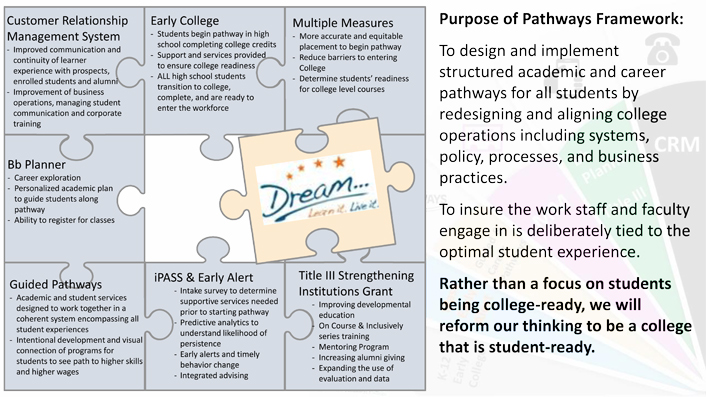
Northeast Wisconsin Technical College (NWTC) Project Integration Summit

Prep Time: 3 months
Presentation Time: 180 minutes
Yield: Awareness, Shared vision, Collaborative culture
Ingredients:
6-7 Project Managers
60-100 Project Committee Members
1 Email Invitation
1 Large Meeting Room
4-5 Desired Outcomes
6 Project Handouts
Dash College Resource Materials
2 Visual Elements
1 Piece Listening
1 Wedge Teaching
1 Break
1 Example of Multiple Projects Working Together
4 Parts Evaluation Method
Optional: Coffee, water, snacks
Directions:
- Combine and engage 6-7 project managers with concept of broadly sharing how all projects are working to achieve college's vision of student success.
- Email 1 invitation to all project committee members to join the college's Executive Leadership Team for a 3-hour project summit.
- Fold in empowerment of project managers with framework, expectations, and 4-5 desired outcomes.
- Prepare large meeting room with multiple tables of 6 chairs per table. Sprinkle dashes of college resource materials and visual elements on each table. Carefully fold in 1 project handout per chair. Greet attendees and direct them to sit at a chair with a project handout they know little or nothing about.
- Open summit and share intended outcomes: Mindset, Transformative Change, Change Leaders, Systems Thinking. This is best done by a member of the Executive Leadership Team closely associated with 1 or more projects. If a member of the Executive Leadership Team is not available, a generic presentation may be used. CAUTION: Results may vary if generic is chosen.
- Introduce Become an Expert Activity by combining 1 Piece Listening for 10 minutes with 1 Wedge of Teaching. Let tables simmer for 30 minutes.
- Blend in a 10-minute break for biological and technology needs.
- Whip together an introduction of Understanding the Student Experience: Connection > Entry > Progress > Completion > Transition
- Whisk together 2 projects currently working together on a common goal related to the student experience, and share with all attendees.
- Swirl together table-conversations of college work related to each component of the Student Experience through a Rapid Fire Activity allowing just 5 minutes for each of the 5 student experience components.
- When done swirling together table conversations, summarize the work and conversations that occurred during the summit in alignment with previously shared desired outcomes.
- Using a 4-part evaluation method, check attendees for doneness: What do they want to know more about? Ask them to identify new communication ideas for continuing to learn about project updates. What new things did attendees learn today? What will attendees do next as change leaders?

WARNING: Preparation of this easily digestible, tasty, calorie-free recipe may result in multiple presentation requests with individual department teams. Use with caution, and be ready to have fun watching eyes and minds open with a broader understanding of how our work must align to prepare for developing the optimal student experience.
Why serve this recipe?
Do you have a nagging feeling someone else at the college is contacting students at the same time you are launching a new calling campaign? Are you frustrated because two of your advising technologies log contacts with students differently and the information isn’t shared between systems or offices? If you feel this way, your executive leadership probably does too.
At NWTC, the light bulbs went off when our VP for Learning and our President attended an AACC Pathways institute in February 2016, followed quickly by DREAM 2016 in Atlanta, GA. They were hearing the same messages about project integration from AACC, AtD, and iPASS and started asking around our college what staff knew about our student success initiatives:
- Why are we doing these large-scale projects?
- What are the outcomes? How will life be different for students?
- What if two projects are working on the same students/technology/initiative?
Guess what? No one had all the answers.
Our President suggested we get the project team members together to learn basic information and start making connections between the projects on which they participate as well as their day-to-day duties. We served the above recipe and managed to exceed all our expectations for engagement and learning!
Up next in our test kitchen: How do we change mindsets to think in systems on a daily basis at all levels of the college?
Currently Learning Division Project Manager at Northeast Wisconsin Technical College overseeing the work of guided pathways and other college-wide projects, Heidi Thomas is transitioning into Associate Dean in the General Studies department. Heidi graduated from the University of Wisconsin-Oshkosh with a degree in Exercise & Fitness, and completed her master's degree in Organizational Leadership at Marian University. Follow her on LinkedIn.
Christine Lemerande, Early Alert System Manager at Northeast Wisconsin Technical College in Green Bay, WI, coordinated NWTC’s Starfish Implementation using 15 years’ experience in Student Services, most recently as the Manger of Admissions and Enrollment. Christine’s biggest challenge is keeping Starfish users swimming in the same direction on a daily basis, and her happiest moments are reading students’ reactions to kudos messages.
